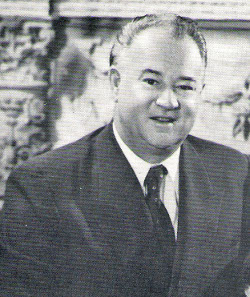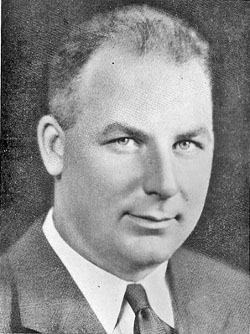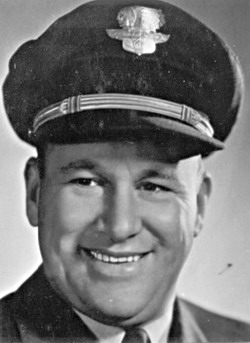A Tribute to TWA..."The Airline Run by Flyers"
Early TWA History from original TWA documents. |
| TWA Founders and Pioneers |
TWA Co-Founder
Paul E. Richter 1898-1949
"Give me enough power and I can fly a barn door"
 A true pioneer during the “Golden Age” of flying, Paul E. Richter played a decisive role in creating and building all aspects of commercial aviation and military air transport. From flight instructor to stunt pilot with Hollywood’s famous 13 Black Cats to Trans World Airlines co-founder and Chief of Staff for the Navy Air Transportation Service during World War II, Richter soared high in his 53 short years. A true pioneer during the “Golden Age” of flying, Paul E. Richter played a decisive role in creating and building all aspects of commercial aviation and military air transport. From flight instructor to stunt pilot with Hollywood’s famous 13 Black Cats to Trans World Airlines co-founder and Chief of Staff for the Navy Air Transportation Service during World War II, Richter soared high in his 53 short years.
A Colorado rancher turned visionary California pilot in the 1920’s, Richter saw the endless opportunities for commercial aviation and made a career of staying ahead of the curve. He founded some of America’s first airlines, flying schools and maintenance facilities. He promoted the skills of female flying students, created high school flying clubs and became one of the world’s first Air Sheriffs. Richter co-founded Aero Corporation of California and Standard Airlines in the 1920s. He co-founded Trans World Airlines through mergers and restructuring in the 1930s and led the growth of commercial aviation from regional to transcontinental to international operations in the 1940s.
With a reputation and passion for the advancement of ground and air safety through research, aircraft design, and technology, Richter spoke frequently on the subject and shared his company’s knowledge with the aviation industry at large. Under his stewardship, T.W.A. made advancements in de-icing, studied electrical phenomena and the benefits of high-altitude flying, and implemented the “Homing” radio direction finder, the anti-range static radio finder, the written flight plan and navigation logs, air brakes or landing flaps, and automatic pilots.
Hundreds of newspaper and magazine articles covered his innovations and accomplishments—noting his two world altitude records, his numerous air race results, his expertise in running airlines, and his influential role as a decorated Navy Officer. The respect of his peers was reflected by his early induction into the exclusive Quiet Birdmen, and also in well-documented personal correspondence.
Richter was a loyal man of principle, integrity and creativity. He adored flying and its enormous potential and did everything in his power to further its development and innovation. In 1949 at the age of 53, Paul Richter died. His contribution to aviation will always be remembered.
|
TWA C0-Founder
William “Jack” Frye 1904-1959
His Motto, "Safety, passenger comfort and schedule"
 William John Frye, known commonly as Jack Frye, had a major impact on the growth of commercial aviation in the United States during his 36 years in the industry. He made vital contributions to the industry's technological progress. Under Frye, Transcontinental and Western Air (T.W.A.) became a leader in high altitude research and fostered the development of a series of advanced transport aircraft. These included the DC-1, DC-2, the Boeing Stratoliner, and Lockheed Constellation. William John Frye, known commonly as Jack Frye, had a major impact on the growth of commercial aviation in the United States during his 36 years in the industry. He made vital contributions to the industry's technological progress. Under Frye, Transcontinental and Western Air (T.W.A.) became a leader in high altitude research and fostered the development of a series of advanced transport aircraft. These included the DC-1, DC-2, the Boeing Stratoliner, and Lockheed Constellation.
Frye was born on March 18th, 1904, near Sweetwater, Oklahoma, to William Henry and Nellie Cooley Frye. His mother died when he was eight years old, and he was raised by his father and grandparents on the family's 15,000-acre ranch in the Texas Panhandle near Wheeler. Frye dropped out of high school at age seventeen and spent a year in the Army Engineer Corps. In 1923 he moved to the Los Angeles area, where he worked as a dishwasher and soda jerk.
To satisfy his interest in flying, Frye used his earnings to take lessons at a local airfield. Before the end of the year, he had borrowed money from his brother to buy a half interest in the Burdett Flying School, whose major asset was a single Curtiss Jenny. Burdett developed slowly adding a second Jenny and expanding into movie stunt flying.
In February 1926 Frye and two associates bought out Burdett Fuller, the original owner of the company and renamed it the Aero Corporation of California. Aero prospered as regional distributor for Eaglerock and Fokker aircraft. It also operated one of the finest flying schools in the country, operated charters, and developed a profitable maintenance business.
On November 28th, 1927, Aero capitalized on the "Lindbergh boom" by forming a subsidiary named Standard Air Lines to begin a scheduled passenger and express service between Los Angeles and Tucson via Phoenix with a six passenger Fokker F-VII. Frye often flew trips for the airline which extended service to El Paso in 1929. That year, Standard became the western link in an air-rail transcontinental schedule. Advertisement brochures described the flight as "the Fair Weather Route." If all went on schedule, the coast-to-coast trip would take in 43 hours and 40 minutes.
In May 1930, Frye and his associates sold Standard Air Line to Harris M. Hanshue of Western Air Express. Frye served in the merged companies as Vice-President for Operations. Before the year ended, Postmaster General Walter Folger Brown forced the merger of Western and Transcontinental Air Transport. Frye remained in charge of operations for the newly formed Transcontinental and Western Air.
Under Frye's direction T.W.A. inaugurated the first all-air transcontinental service on in 1930. Frye played a key role in the search for a replacement for T.W.A.'s Fokker transports, which had been removed from passenger service following an accident on in 1931. In August 1932 Frye wrote to the nation's leading aircraft manufacturers, outlining the specifications for an all-metal, three-engine transport that could carry 12 passengers at a cruising speed of 146 miles per hour over a distance of 1,060 miles. "This plane fully loaded," Frye stressed, "must make satisfactory take-offs under good control at any T.W.A. airport on any combination of two engines." Only Donald Douglas responded to Frye's demanding requirements. The result was the DC-1, a two engine aircraft, capable of take off with a single engine in the event of an engine failure. In 1934, TWA made a dramatic demonstration of the capabilities of the impressive DC-1 in a record-breaking transcontinental flight. The production model, the 14-passenger DC-2, went into service with T.W.A. that same year.
A year that began badly, ended well for Frye. Following a series of reorganizations caused by the Air Mail Act of 1934, which returned the airmail to private contractors, Frye was named president of T.W.A. on December 27th. In the short span of 11 years, Frye had risen from a high school dropout and soda jerk to the youngest airlines president in history. As T.W.A. chronicler Robert J. Serling emphasized, Frye was "Brash, energetic and fiercely competitive, he was the quintessential airline leader at the crossroads in aviation history."
Despite limited financial resources, T.W.A. took the lead in exploring high-speed, high--altitude, all-weather flying. This work led to the development of the Boeing 307 Stratoliner, the first pressurized passenger transport and was introduced by T.W.A. in July 1940. By the time the 307s appeared, T.W.A.'s ownership had changed hands. Frye persuaded Howard Hughes, an old friend, to acquire interest in the company.
T.W.A. continued its technological leadership of the industry. The results of the Hughes involvement could be seen in 1944 when T.W.A. took delivery on the first Lockheed-049 Constellation. In April, Frye and Hughes flew the triple-tail airliner from Burbank to Washington, D.C., in a record six hours and 58 minutes. T.W.A. gained considerable experience on international routes during the war years. Frye used the airline's wartime work to challenge Pan  American's monopoly of overseas markets. In July 1945 the Civil Aeronautics Board granted T.W.A. the authority to fly to Europe, with onward rights to India. In August 1946, the airline received permission to fly across southern Asia to Shanghai. American's monopoly of overseas markets. In July 1945 the Civil Aeronautics Board granted T.W.A. the authority to fly to Europe, with onward rights to India. In August 1946, the airline received permission to fly across southern Asia to Shanghai.
Frye's own tenure with T.W.A. came to an end in February 1947 over an ongoing power struggle with Howard Hughes’ chief assistant, Noah Dietrich. During that time Frye had been dealing with the temporary grounding of T.W.A.'s Lockheed Constellations, a pilots' strike, and the post war recession. The combination of these things gave Dietrich the ammunition that he needed to get rid of his hated rival and Frye resigned to avoid being fired.
Frye however landed on his feet. He became president of the General Aniline and Film Corporation at a salary that was four times what he had earned with T.W.A. In 1955 Frye resigned from General Aniline and formed his own company, The Frye Corporation, to develop a rugged tri-motored airplane for use in underdeveloped countries. The Northrop Company built a prototype, called the Pioneer, which Frye used to attract potential investors and customers. He raised $2 million for the project, to which he added his own savings. He moved to Tucson, Arizona, and was planning a site for his factory when he was struck and killed by a drunk driver on February 3, 1959.
|
TWA Co-Founder
Walter “Ham” A. Hamilton 1902-1946
"Walt Hamilton can make a washing machine fly” Paul E. Richter
 Walter Hamilton was one of the founders of Aero Corporation of California and Standard Airlines and served both as Vice President of Mechanical Operations and continued in a comparable position with Trans World Airlines. Walter Hamilton was one of the founders of Aero Corporation of California and Standard Airlines and served both as Vice President of Mechanical Operations and continued in a comparable position with Trans World Airlines.
Walt learned to fly in the early days of aviation in a 'Jenny' and earned his Transport license the same time of his partners Paul Richter and Jack Frye. In his career he flew many types and sizes of airplanes but his true love lied in his ability to make improvements to both automobile and aircraft engines. Walt was credited early in his mechanical career with perfecting the Duesenberg engine which, at the time, made it the fastest automobile in the world. Also a genius at tuning airplane engines, Walt made alterations to the engines of his partners Paul Richter and Jack Frye’s aircraft that won numerous air races and set altitude records.
Walt as vice-president and chief engineer of Aero Corp not only knew his planes but his maintenance shop was considered the “best in the west” and in 1929 employed 86 men. These men thought Walt should sit in his mahogany-furnished office and do nothing more strenuous than push buttons and dictate letters. Walt however thought it more “fitting” he spend his time taking apart engines, delving into their intricate mechanical problems and getting covered with grease. The Pratt & Whitney engines that pulled the Standard Air Lines' planes from Los Angeles to El Paso, Texas, were the vice-president's special delight. "Upon his shoulders rest the responsibility for the safe performance of his company's planes." Paul Richter 1930.
Walt was an authority of both water and air-cooled engines and was known as the inventor of the DELCO dual ignition system for the OX5 engine. He was also noted for patenting many mechanical techniques that set the standard for efficiencies in aircraft maintenance procedures used in today’s airlines. Walt both as an executive of Douglas Aircraft and later with T.W.A., aided in the construction of the first Douglas transports, the Boeing Stratoliner, and the Lockheed Constellation.
Walt also contributed his genius to the war effort. During WWII, Captain Walter A. Hamilton served in the Naval Air Transport Service, NATS. His expertise in engineering, engines and aircraft were invaluable to the military.
Walt returned to TWA after WWII where he remained until his untimely death in 1946 at age 44. Walt Hamilton was an aviation pioneer and a legend.
|
 |
TWA Pioneer
Vice President of Engineering,
D. W. 'Tommy' Tomlinson
April 28, 1897 - January 7, 1996
Know as a Champion Flyer of the 1920s, Famous High Altitude Test Pilot of the 1930s...Engineer of the Douglas Transport, DC-1, his specs for TWA set Donald Douglas in the forefront of passenger transportation with the DC-2 and DC-3.
|
 |
TWA Pioneer
Vice President of Operations,
Lawrence 'Larry' G. Fritz
1896 - Nov 4, 1970
Lawrence George, known as Larry, sailed on the Great Lakes before joining the army in 1917. He took pilot training and after a brilliant career made Major General in 1944.
L. G. Fritz contributed a great deal to airline development during the formative years. He was test pilot for Ford Airways, chief pilot of Maddux Air Lines, vice-president of Southwest Air Fast Express, Divisional Superintendent of TWA then Vice-President of Operations for TWA.
|
 |
TWA Pioneer
Los Angeles Chief Pilot,
George Rice
It was tough being an airline pilot in the 30's, George Rice, right, was one of TWA's million mile pilots and one of the most illustrious pilots, as Chief Pilot, in L.A. He retired in 1957. This picture was sent to Paul Richter and signed: "Best wishes for a Merry Xmas, Geo Rice" after surviving a Northrop Alpha NR999Y crash, Nov. 15, 1934. |
|
| All materials on this Web site unless otherwise notated are copyrighted © and the exclusive property of the Ruth Richter-Holden Family. No Text, photograghs or content may be reproduced in any manner without the expressed permission of Ruth Richter-Holden. |
|